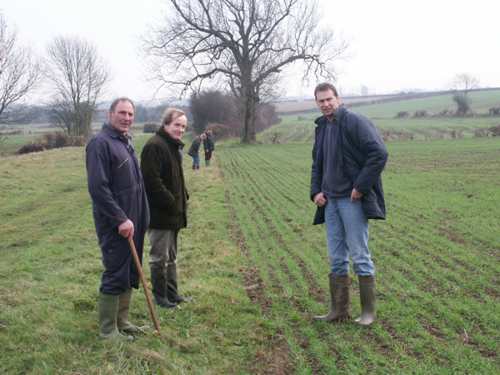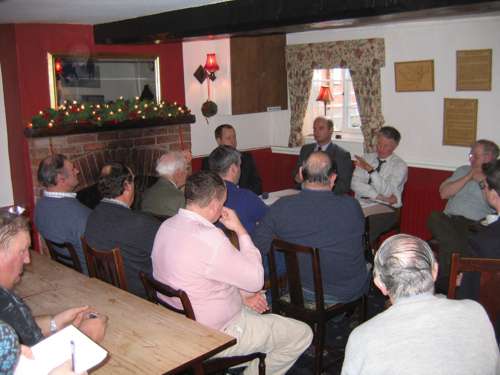|

Jury Day
Jury Day in Laxton takes
place on the last Thursday in November. The Bailiff - a position
currently held by Robert Haigh - selects the Jury of twelve from the
Laxton tenants. A foreman, chosen by the the Court and automatically a
member of the Jury, holds office for each field. The foreman of
the wheat field leads the inspection of the strip boundaries, the dykes
(ditches) and roadways of that field.
The Jury walks the field,
discussing any instances of ploughing over boundaries or failing to
plough right up to them. Stakes are carried into the field and knocked
in at the junction of each strip to denote the correct position. Any
contraventions are noted and these are recorded by the
Bailiff on a 'Presentment Paper' during a discussion after lunch. The
Presentment Paper is put before the Steward of the Court Leet the
following week when fines are decided. The farmers are invited to appeal and the fine is
applied if they are found to be guilty. |
 The Court Leet
The Court Leet is the legally
constituted ancient manorial court of Laxton. The Court is held a week
after Jury Day, on the first Thursday in December. The Court hearing is
called by the Bailiff. The Court convenes at The Dovecote Inn and all
names on the Manor Suite Roll must attend. The penalty for
non-attendance is 2p, and is collected by the Bailiff.
The Court Leet of Laxton
was the only one of its kind to retain full powers to determine legal
proceedings and levy fines under the Administration of Justice Act
(1977).
The survival of the
management system alongside a functioning strip farming system makes
Laxton truly unique.
The Court is presided over and advised
by the Steward of the Manor, a Newark solicitor, appointed by the Crown
Estate. He hears appeals to the fines and swears in members of the Jury
for the coming year in the traditional manner.
|
|
Laxton Grass Sales
The three Open Fields each contain
areas which are too wet or too steep to be cultivated. These areas,
which are not part of any tenancy, provided the farmers of old with
somewhere to turn their horses when they ploughed and most incorporate a
cart road or drainage ditch. These areas, known as ‘sykes’ (pronounced
‘six’), are designated unimproved meadowland and have never been treated
with fertilisers or chemicals. Some are also designated SSSIs (Sites of
Special Scientific Interest).
The grass and wild flowers which grow
on the sykes make wonderful hay. The right to make this hay is sold by
an independent auctioneer at the annual Grass Sales to ‘anyone who puts
smoke up a chimney in Laxton’ i.e. tenants of the Laxton Crown Estate.
The grass may not be cut before July 15th under the current Countryside
Stewardship scheme, so in recent times the sale has been in early July.
In the past the sale often took place on the longest day with the
payment falling due on the shortest day - allegedly to give the buyer
the minimum time to worry about it on the day! The proceeds of the sale
go into the Laxton Gaits and Commons account and help towards the upkeep
of the roads of the Open Fields. The sale of each of the 26 parcels of
land is also subject to a £2 levy to pay for refreshments in The
Dovecote afterwards. The photos
show the processes of cutting hay, turning it by hand and
mechanically and making small bales, suitable for individual horse
owners.
|

